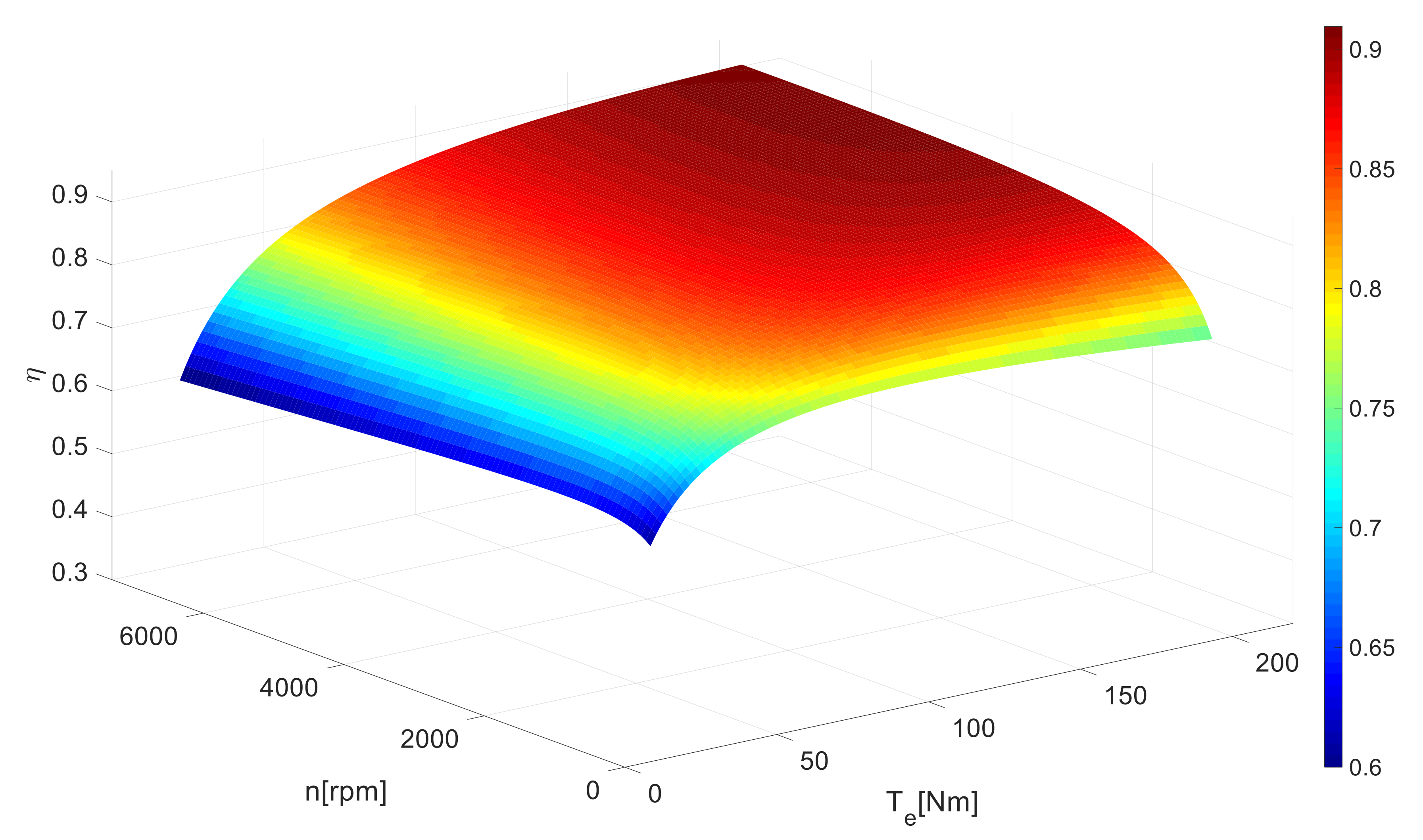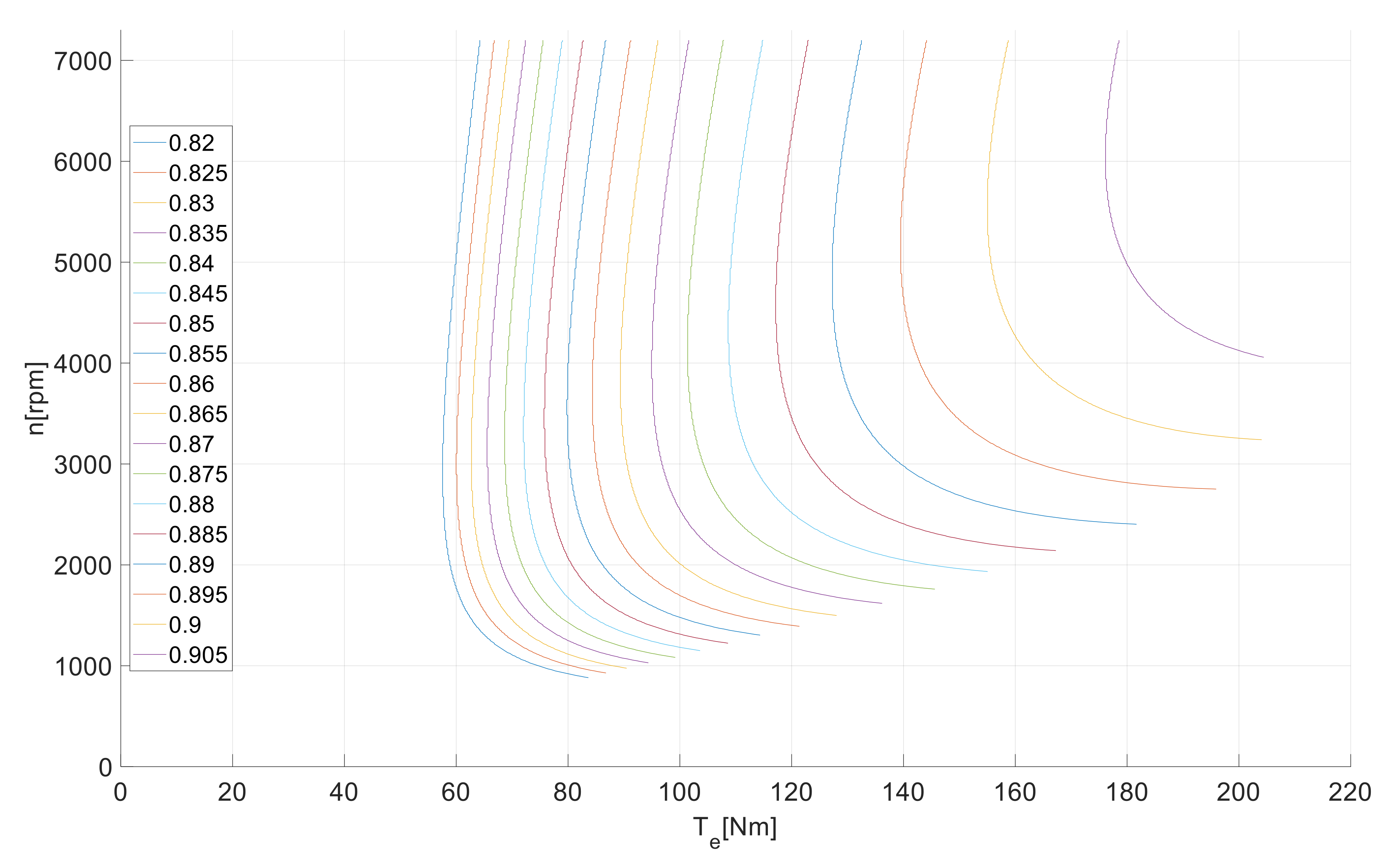Efficiency Analytical Characterization for Brushless Electric Drives
Abstract
:1. Introduction
2. Configuration of the Brushless Electric Drive
- ▪
- The three phase AC Permanent Magnet Synchronous Machine (PMSM);
- ▪
- The three phase DC/AC Voltage Source Converter (VSC);
- ▪
- The Energy Storage System (ESS), built upon the series/parallel connection of a proper number of electrochemical cells and the correspondent Battery Management System (BMS);
- ▪
- The mechanical power transmission components needed to interface the electric machine to the remaining core elements of the traction system;
- ▪
- The low-level controller of the brushless drive;
- ▪
- The high-level controller of the whole system, i.e., the power management unit.
- ▪
- VSC conduction losses;
- ▪
- VSC switches losses;
- ▪
- PMSM iron losses;
- ▪
- PMSM joule losses;
- ▪
- PMSM mechanical losses.
3. Proposed Procedure for Efficiency Analytical Characterization
- ▪
- Motor average speed
- ▪
- Motor available average torque
- ▪
- DC-Link average voltage
- ▪
- DC-Link average current
- ▪
- AC rms current
- ▪
- Motor windings temperature
- ▪
- The conduction power losses in the converter depend on
- ▪
- The switching power losses in the converter vary linearly with
- ▪
- The stator iron losses driven by armature reaction depend on
4. Experimental Results
- ✓
- average value of available torque
- ✓
- average value of rotational speed in rpm
- ✓
- RMS value of the AC phase current
- ✓
- average value of the DC-Link voltage
- ✓
- average value of the DC-Link current
- ✓
- temperature of the motor windings
5. Conclusions
Author Contributions
Funding
Institutional Review Board Statement
Informed Consent Statement
Data Availability Statement
Conflicts of Interest
Nomenclature
| the temperature coefficient of the stator winding conductor | |
| System efficiency function | |
| Motor windings temperature | |
| Permanent magnets flux | |
| Motor average speed | |
| Motor speed series | |
| DC-Link average current | |
| AC rms current | |
| Polynomial coefficients | |
| L | Stator phase inductance |
| Converter power losses | |
| Polynomial coefficients | |
| Total iron losses at zero current | |
| Input power | |
| Stator joule power losses | |
| mechanical power transferred to the load | |
| Mechanical losses | |
| Output power | |
| Total power losses | |
| Polynomial coefficients | |
| the phase stator resistance at 20 °C | |
| Motor available average torque | |
| Motor torque series | |
| DC-Link average voltage | |
| Superscript to indicate the evaluation in a rth point of the motor torque series | |
| Superscript to indicate the evaluation in a kth point of the motor speed series |
References
- International Energy Agency (IEA). Global EV Outlook 2018. Towards cross-model electrification. In Electric Vehicles Initiative; IEA Publications: Paris, France, 2018; pp. 143–144. [Google Scholar]
- De Almeida, A.T.; Ferreira, F.J.T.E.; Baoming, G. Beyond Induction Motors—Technology Trends to Move Up Efficiency. In Proceedings of the IEEE Transactions on Industry Applications, Stone Mountain, GA, USA, 30 April–3 May 2013; Volume 50, pp. 2103–2114. [Google Scholar] [CrossRef]
- Ni, R.; Xu, D.; Wang, G.; Ding, L.; Zhang, G.; Qu, L. Maximum Efficiency Per Ampere Control of Permanent-Magnet Synchronous Machines. In IEEE Transactions on Industrial Electronics; IEEE: New York, NY, USA, 2015; Volume 62, pp. 2135–2143. [Google Scholar]
- Balamurali, A.; Feng, G.; Lai, C.; Loukanov, V.; Kar, N.C. Investigation into variation of permanent magnet synchronous motor-drive losses for system level efficiency improvement. In Proceedings of the IECON 2017—43rd Annual Conference of the IEEE Industrial Electronics Society, Beijing, China, 29 October–1 November 2017; pp. 2014–2019. [Google Scholar]
- Lee, J.; Nam, K.; Choi, S.; Kwon, S. Loss-Minimizing Control of PMSM With the Use of Polynomial Approximations. In Proceedings of the IEEE Transactions on Power Electronics, Edmonton, AB, Canada, 5–9 October 2008; Volume 24, pp. 1071–1082. [Google Scholar]
- Deng, W.; Zhao, Y.; Wu, J. Energy Efficiency Improvement via Bus Voltage Control of Inverter for Electric Vehicles. In IEEE Transactions on Vehicular Technology; IEEE: New York, NY, USA, 2017; Volume 66, pp. 1063–1073. [Google Scholar]
- Zhang, C.; Guo, Q.; Li, L.; Wang, M.; Wang, T. System Efficiency Improvement for Electric Vehicles Adopting a Permanent Magnet Synchronous Motor Direct Drive System. Energies 2017, 10, 2030. [Google Scholar] [CrossRef] [Green Version]
- Martinez, C.M.; Hu, X.; Cao, D.; Velenis, E.; Gao, B.; Wellers, M. Energy Management in Plug-in Hybrid Electric Vehicles: Recent Progress and a Connected Vehicles Perspective. In IEEE Transactions on Vehicular Technology; IEEE: New York, NY, USA, 2017; Volume 66, pp. 4534–4549. [Google Scholar] [CrossRef] [Green Version]
- Wang, X.; He, H.; Sun, F.; Sun, X.; Tang, H. Comparative Study on Different Energy Management Strategies for Plug-In Hybrid Electric Vehicles. Energies 2013, 6, 5656–5675. [Google Scholar] [CrossRef]
- Du, A.; Chen, Y.; Zhang, D.; Han, Y. Multi-Objective Energy Management Strategy Based on PSO Optimization for Power-Split Hybrid Electric Vehicles. Energies 2021, 14, 2438. [Google Scholar] [CrossRef]
- De Almeida, A.T.; Ferreira, F.J.T.E.; Duarte, A.Q. Technical and Economical Considerations on Super High-Efficiency Three-Phase Motors. In Proceedings of the IEEE Transactions on Industry Applications, Stone Mountain, GA, USA, 30 April–3 May 2013; Volume 50, pp. 1274–1285. [Google Scholar] [CrossRef]
- Dambrauskas, K.; Vanagas, J.; Zimnickas, T.; Kalvaitis, A.; Ažubalis, M. A Method for Efficiency Determination of Permanent Magnet Synchronous Motor. Energies 2020, 13, 1004. [Google Scholar] [CrossRef] [Green Version]
- IEEE. IEEE Trial-Use Guide for Testing Permanent Magnet Machines in IEEE Std 1812–2014; IEEE: New York, NY, USA, 2015; pp. 1–56. [Google Scholar] [CrossRef]
- IEC 61800-9-2. Adjustable Speed Electrical Power Drive Systems. March 2017. Available online: https://webstore.iec.ch/publication/31527 (accessed on 18 February 2022).
- Popescu, M.; Dorrell, D. A method for determining ipm motor parameters from simple torque test data. In Proceedings of the IECON 2013—39th Annual Conference of the IEEE Industrial Electronics Society, Vienna, Austria, 10–13 November 2013; pp. 7290–7294. [Google Scholar] [CrossRef]
- Candelo-Zuluaga, C.; Riba, J.-R.; Garcia, A. PMSM Torque-Speed-Efficiency Map Evaluation from Parameter Estimation Based on the Stand Still Test. Energies 2021, 14, 6804. [Google Scholar] [CrossRef]
- Puron, L.D.R.; Neto, J.E.; Fernández, I.A. Neural networks based estimator for efficiency in VSI to PWM of induction motors drives. In Proceedings of the 2016 IEEE International Conference on Automatica (ICA-ACCA), Curico, Chile, 19–21 October 2016; pp. 1–8. [Google Scholar] [CrossRef]
- Deusinger, B.; Lehr, M.; Binder, A. Determination of efficiency of permanent magnet synchronous machines from summation of losses. In Proceedings of the 2014 International Symposium on Power Electronics, Electrical Drives, Automation and Motion, Ischia, Italy, 18–20 June 2014; pp. 619–624. [Google Scholar] [CrossRef]
- Urasaki, N.; Senjyu, T.; Uezato, K. Influence of all losses on permanent magnet synchronous motor drives. In Proceedings of the 2000 26th Annual Conference of the IEEE Industrial Electronics Society. IECON 2000. 2000 IEEE International Conference on Industrial Electronics, Control and Instrumentation. 21st Century Technologies, Nagoya, Japan, 22–28 October 2000; Volume 2, pp. 1371–1376. [Google Scholar] [CrossRef]
- Dabala, K. Analysis of mechanical losses in three-phase squirrel-cage induction motors. In Proceedings of the ICEMS’2001. Proceedings of the Fifth International Conference on Electrical Machines and Systems (IEEE Cat. No.01EX501); Shenyang, China, 18–20 August 2001, Volume 1, pp. 39–42. [CrossRef]
- Yang, G.; Zhang, S.; Zhang, C. Analysis of Core Loss of Permanent Magnet Synchronous Machine for Vehicle Applications under Different Operating Conditions. Appl. Sci. 2020, 10, 7232. [Google Scholar] [CrossRef]





| Brushless Motor Parker GVM210-300-DPW | |
| DC-Link Voltage | 700 V |
| Rated Power | 155 kW |
| Rated Speed | 7220 rpm |
| Peak Power | 277.8 kW |
| Maximum Speed | 8000 rpm |
| Driver Parker GVI H6500500S1R00 | |
| Rated input Voltage | 650 V |
| Operating range Voltage | 100–750 V |
| Output Current | 375 Arms |
| Rated Power (1 h rating at 4 kHz switching frequency and 60 °C coolant temperature, 85 °C ambient and 18 L/min flow) | 299 kVA |
| 0.937 W/rpm | |
| 53 μW/rpm2 | |
| 4.244 W/A | |
| 21.9 mW/A2 | |
| 10.53 A | |
| 0.963 A/Nm | |
| 0.54 mA/(Nm)2 |
Publisher’s Note: MDPI stays neutral with regard to jurisdictional claims in published maps and institutional affiliations. |
© 2022 by the authors. Licensee MDPI, Basel, Switzerland. This article is an open access article distributed under the terms and conditions of the Creative Commons Attribution (CC BY) license (https://creativecommons.org/licenses/by/4.0/).
Share and Cite
Brando, G.; Dannier, A.; Del Pizzo, A. Efficiency Analytical Characterization for Brushless Electric Drives. Energies 2022, 15, 2963. https://doi.org/10.3390/en15082963
Brando G, Dannier A, Del Pizzo A. Efficiency Analytical Characterization for Brushless Electric Drives. Energies. 2022; 15(8):2963. https://doi.org/10.3390/en15082963
Chicago/Turabian StyleBrando, Gianluca, Adolfo Dannier, and Andrea Del Pizzo. 2022. "Efficiency Analytical Characterization for Brushless Electric Drives" Energies 15, no. 8: 2963. https://doi.org/10.3390/en15082963
APA StyleBrando, G., Dannier, A., & Del Pizzo, A. (2022). Efficiency Analytical Characterization for Brushless Electric Drives. Energies, 15(8), 2963. https://doi.org/10.3390/en15082963








